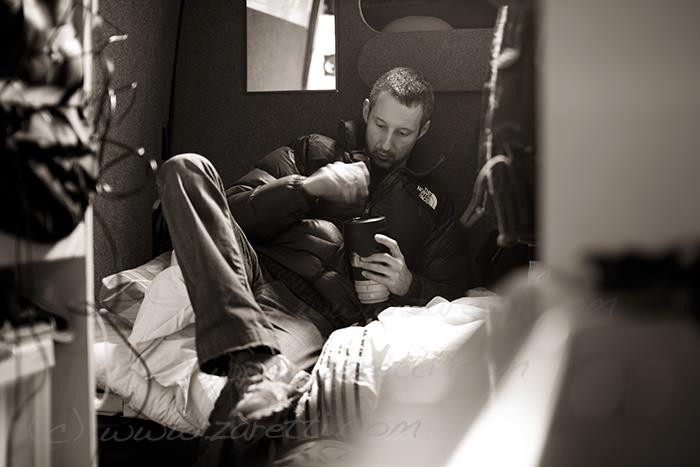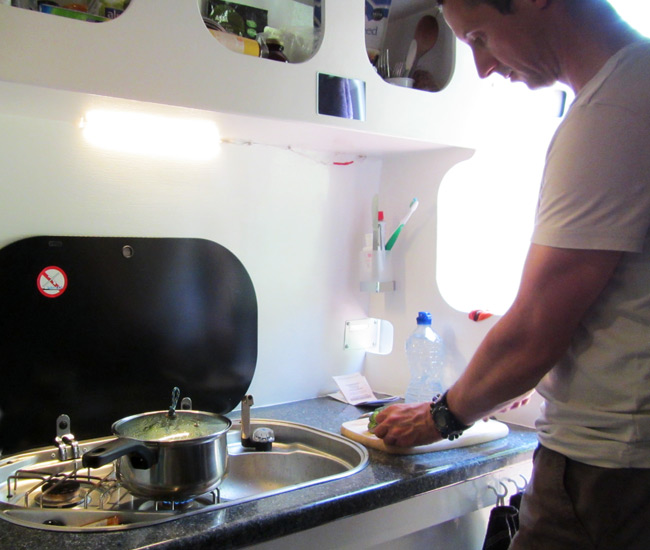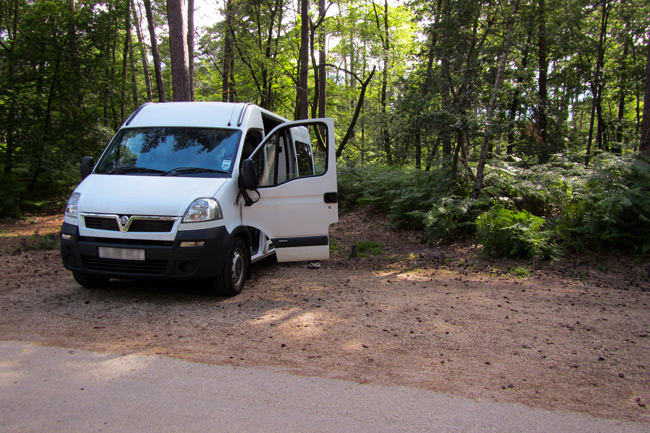Discover the Five Rules and Five “S”s to a safe night’s sleep!
Living off the Grid means different things to different people but keeping it simple for the purpose of this article let’s just assume that we mean “living in a campervan“, which may be covert or overt (stealth van). For many years my “boring” white van had no external clues that inside was actually a mobile home, it didn’t even have the window in the sliding door at the time… that came later. It was just another “white van”. I kept the cab tidy and avoided trappings of home in plain sight, such as photos, plants, cooking equipement and clothing. Anyone looking in would just assume it’s a builders van (although a suprisingly clean one!).

For 9 months I lived in that van while I was waiting for my house, 250 miles away, to sell and the purchase of my new home to complete. I could have rented a flat but I decided not to. I actually wanted to see if it was possible to live in a van, off the grid, in a busy city with no address, no bills, no council tax, no worries! Some of the time I was at my then girlfriend’s place but overall I was in my van and quite happy. I didn’t have Blue my trusted copilot with me at the time. I have also lived short stay in London and even Barcelona using the strategies and tactics I list below.
“Shhhh! Zombies!”
This became the code for when people were outside the van. You see the single biggest risk is people. Or zombies as I referred to them. Let me explain why “zombies” fits the bill. Where I was based was near a university campus and at 1am you don’t get people walking past, you get brain dead drunk students who think it’s really funny to smack the side of a van if they know you’re in there! So now begins the rules of avoiding a zombie attack while sleeping in your campervan.
Rule 1: Stealth
You should be invisible. There’s no point sliding the side door open, standing there in your dressing gown and having a big morning stretch and then wondering how the local neighbourhood have managed to figure out your sleeping in your van. My van has a hatch concealed in the bulk head, which allows me to view the mirrors so I could see out the front and also down both side mirrors before opening the door. It’s not about paranoia it’s about not drawing unecessary attention to you and your van.
Rule 2: Location
Choose your spot wisely. If it’s on a hill then consider the direction of the hill and how that’s going to affect your sleep. Would you rather have your head or feet pointing uphill? Look around and note buildings and facilities which may be useful to you or which may attract the wrong sort of people such as nightclubs and bars. If you’re on the road near a pub then that means a higher chance of zombie attacks from the drunk braindead. If there’s a public toilet nearby then that’s a bonus. If there’s a kids school just down the road then probably not the best spot as people will always jump to the wrong conclusion.
Rule 3: Timing
If it’s 5:30pm and the street is really busy then walking up to your van, opening the door and letting about 20 strangers who are sharing the pavement all get a good look in your van is probably not the best idea. If someone is walking behind me and I’m approaching my van then I either stop and act like I’ve got something to do like answer my phone or tie a shoe lace. When the coast is clear then I’ll open the door.
Rule 4: Make Your Van Invisible and Boring
Take a subjective look at your van and decide if it’s giving the game away. What I like to call “The Five ‘S’s“.
- Signals: For example have you got smoke coming out of a wood burning stove? Or water dripping out of your overflow pipe/sing drain?
- Sounds: Is the music from your radio audible from the outside? I’ve insulated my van quite well and I know how loud the music can be before it can be heard from people passing.
- Spill: Is light leaking from the windows, curtains, sunroof? My van has inner curtains which cover the sun-roof as well as the side window. The reason for the sunroof is that at night, if the houses I’m parked near are tall then people will see the light from the upper floor windows. Basically you want to prevent light spilling out from your van.
- Sway: How much does the van sway and rock around as a result of your movement inside it. I was once in the van at a secure office facility where I rented office space. I was in the back cooking some food and it was about 9pm. I heard voices and then someone tried to open the back door. Luckily I have a secure lock on the inside of the rear van doors. So I came out the side and faced 3 security guards (rentacop). “Is anything wrong only you’re trying to enter my van without my consent?”. “Oh sorry we just saw the van rocking and thought we’d better check it out”. “Thanks, I’m just sorting out some equipment in there. This is my office.” I said pointing to my office “and I’m working late”. Up to that point I hadn’t really considered that the movement inside would be visible. But a few inches of suspension movement means about a foot of sway at the roof especially when your van is 2.5m tall!
- Smells: Nothing says someone is home more than the smell of a curry being cooked. If you’ve cracked open the window or you’ve got a vent of some kind are the smells of your cooking giving the game away? And if you’re using a night bottle to pee in, then for crying out loud, don’t just open the door and tip it in the gutter. Firstly that’s just not good, nice or kind for others. But secondly that’s going to smell. Instead deal with it in a more responsible way, such as tipping it into a public toilet or a proper site. At the very least walk into the woods away from people and water the plants.

Rule 5: Avoid Making Mistakes That Get Police Attention
When parking overnight you can unwittingly get the attention of the police/council simply for parking badly. So these are the UK Government/Highways Agency rules for parking overnight (as of 18 June 2014) see https://www.gov.uk/waiting-and-parking for more info.
- Waiting and parking (238)
238 You MUST NOT wait or park on yellow lines during the times of operation shown on nearby time plates (or zone entry signs if in a Controlled Parking Zone) – see ‘Traffic signs’ and ‘Road markings’. Double yellow lines indicate a prohibition of waiting at any time even if there are no upright signs. You MUST NOT wait or park, or stop to set down and pick up passengers, on school entrance markings (see ‘Road markings’) when upright signs indicate a prohibition of stopping.
Law RTRA sects 5 & 8
- Parking (239 to 247)
239 Use off-street parking areas, or bays marked out with white lines on the road as parking places, wherever possible. If you have to stop on the roadside:
- do not park facing against the traffic flow
- stop as close as you can to the side
- do not stop too close to a vehicle displaying a Blue Badge: remember, the occupant may need more room to get in or out
- you MUST switch off the engine, headlights and fog lights
- you MUST apply the handbrake before leaving the vehicle
- you MUST ensure you do not hit anyone when you open your door. Check for cyclists or other traffic
- it is safer for your passengers (especially children) to get out of the vehicle on the side next to the kerb
- put all valuables out of sight and make sure your vehicle is secure
- lock your vehicle
- Laws CUR reg 98, 105 & 107, RVLR reg 27 & RTA 1988 sect 42
240 You MUST NOT stop or park on:
- the carriageway or the hard shoulder of a motorway except in an emergency (see Rule 270)
- a pedestrian crossing, including the area marked by the zig-zag lines (see Rule 191)
- a clearway (see ‘Traffic signs’)
- taxi bays as indicated by upright signs and markings
- an Urban Clearway within its hours of operation, except to pick up or set down passengers (see ‘Traffic signs’)
- a road marked with double white lines, even when a broken white line is on your side of the road, except to pick up or set down passengers, or to load or unload goods
- a tram or cycle lane during its period of operation
- a cycle track
- red lines, in the case of specially designated ‘red routes’, unless otherwise indicated by signs. Any vehicle may enter a bus lane to stop, load or unload where this is not prohibited (see Rule 140).
- Laws MT(E&W)R regs 7 & 9, MT(S)R regs 6 & 8, ZPPPCRGD regs 18 & 20, RTRA sects 5, 6 & 8, TSRGD regs 10, 26 & 27, RTA 1988 sects 21(1) & 36
241 You MUST NOT park in parking spaces reserved for specific users, such as Blue Badge holders, residents or motorcycles, unless entitled to do so.
Laws CSDPA sect 21 & RTRA sects 5 & 8
242 You MUST NOT leave your vehicle or trailer in a dangerous position or where it causes any unnecessary obstruction of the road.
Laws RTA 1988, sect 22 & CUR reg 103
243 DO NOT stop or park:
- near a school entrance
- anywhere you would prevent access for Emergency Services
- at or near a bus or tram stop or taxi rank
- on the approach to a level crossing/tramway crossing
- opposite or within 10 metres (32 feet) of a junction, except in an authorised parking space
- near the brow of a hill or hump bridge
- opposite a traffic island or (if this would cause an obstruction) another parked vehicle
- where you would force other traffic to enter a tram lane
- where the kerb has been lowered to help wheelchair users and powered mobility vehicles
- in front of an entrance to a property
- on a bend
- where you would obstruct cyclists’ use of cycle facilities except when forced to do so by stationary traffic.
244 You MUST NOT park partially or wholly on the pavement in London, and should not do so elsewhere unless signs permit it. Parking on the pavement can obstruct and seriously inconvenience pedestrians, people in wheelchairs or with visual impairments and people with prams or pushchairs.
Law GL(GP)A sect 15
245 Controlled Parking Zones. The zone entry signs indicate the times when the waiting restrictions within the zone are in force. Parking may be allowed in some places at other times. Otherwise parking will be within separately signed and marked bays.
246 Goods vehicles. Vehicles with a maximum laden weight of over 7.5 tonnes (including any trailer) MUST NOT be parked on a verge, pavement or any land situated between carriageways, without police permission. The only exception is when parking is essential for loading and unloading, in which case the vehicle MUST NOT be left unattended.
Law RTA 1988 sect 19
247 Loading and unloading. Do not load or unload where there are yellow markings on the kerb and upright signs advise restrictions are in place (see pages 115-116). This may be permitted where parking is otherwise restricted. On red routes, specially marked and signed bays indicate where and when loading and unloading is permitted.
Law RTRA sects 5 & 8
- Parking at night (248 to 252)
248 You MUST NOT park on a road at night facing against the direction of the traffic flow unless in a recognised parking space. Laws CUR reg 101 & RVLR reg 24
249 All vehicles MUST display parking lights when parked on a road or a lay-by on a road with a speed limit greater than 30 mph (48 km/h).
Law RVLR reg 24
250 Cars, goods vehicles not exceeding 1525 kg unladen weight, invalid carriages, motorcycles and pedal cycles may be parked without lights on a road (or lay-by) with a speed limit of 30 mph (48 km/h) or less if they are:
at least 10 metres (32 feet) away from any junction, close to the kerb and facing in the direction of the traffic flow
or
in a recognised parking place or lay-by.
Other vehicles and trailers, and all vehicles with projecting loads, MUST NOT be left on a road at night without lights.
Laws RVLR reg 24 & CUR reg 82(7)
251 Parking in fog. It is especially dangerous to park on the road in fog. If it is unavoidable, leave your parking lights or sidelights on.
252
Parking on hills. If you park on a hill you should:
park close to the kerb and apply the handbrake firmly
select a forward gear and turn your steering wheel away from the kerb when facing uphill
or
select reverse gear and turn your steering wheel towards the kerb when facing downhill
use ‘park’ if your car has an automatic gearbox.
You’ll notice there is nothing in there about whether you can sleep in your van or not. But it does state parking and waiting. If I were to be stopped by a bobby and asked what I’m doing I’d tell them that I am “waiting”. Since in order to have a conversation I must be awake and since my van doesn’t allow them to pry inside then there is no way they would know I was sleeping unless I told them so. Even if I had my eyes closed I can say I am ‘meditating’, which in reality I probably am 🙂


